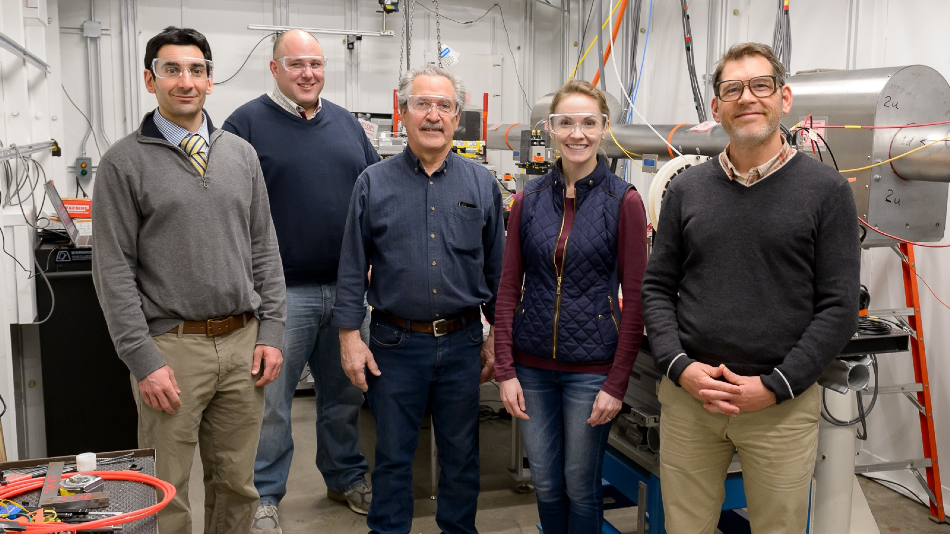Jul 2 2020
Opportunities for more improved and versatile studies are one of the aspects that bring researchers together. A team of researchers has now collaborated for a similar case.
 Members of the collaboration that built the new instrument at the APS. From left: Michael Sangid, Purdue University; Aaron Stebner, Colorado School of Mines; Bob Suter, Carnegie Mellon University; Ashley Spear, University of Utah; and Jonathan Almer, X-ray Science division, Argonne. Photo taken in December 2019. Image Credit: Wes Agresta/Argonne National Laboratory.
Members of the collaboration that built the new instrument at the APS. From left: Michael Sangid, Purdue University; Aaron Stebner, Colorado School of Mines; Bob Suter, Carnegie Mellon University; Ashley Spear, University of Utah; and Jonathan Almer, X-ray Science division, Argonne. Photo taken in December 2019. Image Credit: Wes Agresta/Argonne National Laboratory.
After witnessing the need for a novel instrument that will speed up studies at one of the most productive X-ray light sources in the world, the researchers have developed an innovative tool to address this requirement.
This novel tool will enable more X-ray experiments to produce three-dimensional (3D) views of a variety of materials, allowing materials discovery and providing new possibilities for users.
At the U.S. Department of Energy’s (DOE) Argonne National Laboratory, scientists have been employing beamline 1-ID at the lab's Advanced Photon Source (APS)—a DOE Office of Science User Facility—to perform non-destructive X-ray diffraction measurements of metals, ceramics, as well as other polycrystalline materials on the grain scale.
Users from across the world bring their samples to the Argonne National Laboratory, where Argonne’s beamline researchers help gather and examine this 3D grain-resolved data.
The intrinsically flexible nature of the beamline, particularly for in situ measurements, and its potential to offer advanced data about different types of materials, have made it quite popular among the research community. The instrument is so popular that wait times to use it have increased.
Consequently, in a case of coordinated pioneering leadership between Argonne National Laboratory and many other institutions across the nation, researchers have created a group to head the development of a novel instrument.
Dubbed High-Throughput High-Energy Diffraction Microscopy Instrument (HT-HEDM), the latest device will be installed at the APS and will offer a more assembly line-like method to acquire this 3D information.
The HT-HEDM instrument is situated in the 6-ID-D end-station. Together with the 1-ID beamline, the HT-HEDM has a superconducting undulator that provides world-class X-ray fluxes in the high-energy range, that is, 40 to 120 keV.
With the HT-HEDM instrument, researchers can perform high-throughput X-ray diffraction imaging experiments and get a one-stop solution for an array of different studies. This would also allow scientists to increasingly use the 1-ID beamline for technique development that will prove handy when the APS Upgrade of Argonne National Laboratory comes online in a few years time.
This new instrument will take pressure off the measurements that we’re doing now at 1-ID, so that we can create techniques that take advantage of the added brilliance and coherence of the upgraded storage ring.
Jonathan Almer, Group Leader and Physicist, X-ray Science Division, Argonne National Laboratory
The HT-HEDM instrument will employ high-energy X-rays for nondestructive inspections of materials and produce 3D representations that can be constantly viewed over time.
One of the advantages of this kind of diffraction is that you can look at the same sample multiple times and see how its characteristics and structure change.
Bob Suter, Emeritus Professor of Physics, Carnegie Mellon University
Suter is also a founding member of the group that is heading the construction at 6-ID-D.
A few cases of such materials comprise components for nuclear reactors and aerospace, in which microstructural variations take place owing to mechanical stresses, temperature, and (in the former case) irradiation.
Upon arrival of the APS Upgrade, Almer and his collaborators believe that these methods can be used for analyzing energy materials like anodes and cathodes for batteries.
Right now, the grain size of battery components is too small to resolve with these techniques, but the APS Upgrade will give us the opportunity to examine many of them with sufficient resolution.
Jonathan Almer, Group Leader and Physicist, X-ray Science Division, Argonne National Laboratory
Since the HT-HEDM instrument will enable investigators to exchange the experiments and samples much more easily, Almer believes that this would help perform mail-order experiments.
“You could imagine that once we’re up and running, people from around the world could send us their samples, and we could collect the data and send it back to them, much like is being done at other beamlines at the APS,” he added.
One specific benefit of the novel instrument is its potential to take measurements that are analogous to—but more responsive than—electron back-scattered diffraction measurements, which can be taken at scores of laboratories across the nation.
“Essentially, you could think that there are many places with wading pools in their backyards, but this instrument, by comparison, will be an Olympic swimming pool,” added Suter.
The consortium developing the new instrument comprises faculty at and funding from Carnegie Mellon University, the Colorado School of Mines, Purdue University, and the University of Utah.
Key funding is offered by the National Science Foundation’s Major Research Instrumentation Program; the APS offers extensive logistics, staff, and engineering support. The DOE’s Office of Science supports the APS.